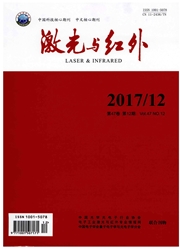

 中文摘要:
中文摘要:
温度冲击下锑化铟(In Sb)面阵探测器典型碎裂统计结果表明,起源于N电极区域的裂纹在芯片碎裂中占据主导。为研究温度冲击下N电极结构尺寸和材料选取对In Sb红外面阵探测器所积累热应力的影响,借助ANSYS软件,基于"先分割,后等效"的建模思想,建立了128×128 In Sb红外面阵探测器结构分析模型。模拟结果显示,随着N电极厚度的增加,In Sb芯片和N电极上累积的热应力极值和Z方向应变极值都呈现出减小趋势,即N电极越薄,In Sb芯片和N电极上热应力和应变极值越大。在N电极选取金和铟两种不同材料时,In Sb芯片和N电极上累积的热应力极值也发生迥然不同的变化:选金做N电极时,In Sb芯片上累积热应力极值为503 MPa,在选用铟材料时,其值进一步增加到918 MPa;但此时N电极上热应力极值不是增大,而是从242 MPa下降到2.82 MPa,减小了两个数量级。这表明N电极结构尺寸和材料的变化对In Sb芯片和N电极上热应力/应变有较大的影响。因此,如能选取合适N电极结构尺寸和材料,将有助于减小芯片和N电极应力集中现象,从而降低探测器碎裂几率。
 英文摘要:
英文摘要:
Typical fragmentation statistics analysis of In Sb infrared focal plane array( IRFPA) detector shows the cracks happening in the region of N electrode dominate the fractures of In Sb IRFPA. To study the effects of the structure size and material selection of N electrode on thermal stress of In Sb IRFPA detector,basing on the equivalent modeling method of "first split,then equivalently replace",a structural model of 128 × 128 array is established. Simulation results show that as the N electrode thickness increases,the maximum thermal stress and maximum Z-component of strain in In Sb chip and N electrode both decrease. That means the thinner N electrode leading to larger thermal stress and strain extremum of In Sb chip and N electrode. When gold and indium are respectively adopted as N electrode,the maximum thermal stress in In Sb chip has quite different characteristics from that in N electrode: when gold is used as N electrode,the maximum thermal stress in In Sb chip is 503 MPa,and it increases to 918 MPa with indium used as N electrode; but the change trend for N electrode decreases from 242 MPa to 2. 82 MPa by two orders of magnitude. All these show that the structure size and material selection of N electrode have impacts on the thermal stress and strain in In Sb IRFPA. Therefore,the appropriate selection of structure size and material will benefit to eliminate the stress concentration of In Sb chip and N electrode,and decrease the fracture probability.
 同期刊论文项目
同期刊论文项目
 同项目期刊论文
同项目期刊论文
 期刊信息
期刊信息
